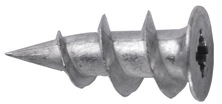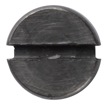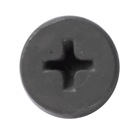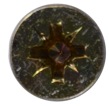Household fixings kit
A basic fixings box that is well stocked with the most commonly used fixings is handy to have alongside your toolbox in the home. You can then refill regularly with the items you use most. The length of fixings you use should always be guided by the manufacturer’s instructions where appropriate. A general guide is that the length of fixing should be three times the depth of the item you are fixing through. For example, if you are fixing a piece of batten, 20mm deep, to the wall, you should use a 60mm fixing. Below is some advice on the type and variety of fixings that you should keep in your fixings box.
Types of nail
| Round wire – common all-purpose nail used for any rough structural work. |
Oval wire – use for fixing mouldings such as skirtings and architrave. |
Masonry – for fixing to any masonry surface. |
Panel pin– ideal for fixing any small mouldings in place.
|
Types of screw
All-purpose – use directly into wood or in combination with a wall plug for masonry. |
Drywall– use for fixing plasterboard sheets to studwork.
|
Single thread – ideal for fixing items like chipboard flooring. |
Self-tapping– a screw with a fine thread designed to cut its own hole and grip in metal surfaces.
|
Wall plugs
Masonry – use in conjunction with a screw when fixing into masonry |
Frame fixing – all in one fixing for masonry wall for more heavyweight requirements. |
Hollow wall – use in conjunction with screw for lightweight fixing into hollow area of stud wall. |
Self drilling – use with screw for medium-weight fixing into the hollow area of stud wall. |
All in one anchor – all in one fixing for the hollow area of a stud wall, ideal for more heavyweight requirements. |
 |
Types of screwhead



Screwhead design
Screwhead design is only relevant to the type of screwdriver head or bit that is required to fix them in place. The most common types are shown below.
| Slot head– traditional design still commonly used when the screwhead is on view.
 |
Phillips– traditional cross head design with the slots being deepest at their centre.
 |
Posidriv– cross head design with four tiny indents between each leg of the cross.
 |
 |
 |
 |
Fixing tips
- When you fix anything to a wall in your home, it is important to determine first whether you are going to be fixing into masonry or stud walls, as this will affect the equipment/fixings required and the technique needed to fix onto the wall.
- Drilling pilot holes helps in several ways. When fixing in wood, they will help prevent the surface splitting when inserting a screw. A pilot hole should be made with a drill bit with a diameter slightly less than the shaft of the screw. When fixing into walls, the pilot hole size is determined by the size of wall plug you need to use.
- For instructions on how to fix into different wall surfaces, see my guides – ‘Fixing into masonry walls’ and ‘Fixing into hollow walls’.


